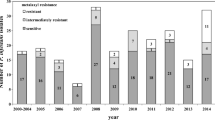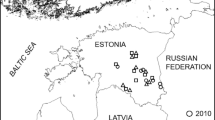Abstract
The characterisation of Phytophthora infestans isolates is a key step in both monitoring population changes and designing control strategies. A collection of 57 isolates (33 from 2003 to 2005 and 24 from 2011 to 2014) of the Spanish population of P. infestans from different potato fields was characterised in this study. Mating types A1 and A2 have been identified for the first time in Spain by using CAPs markers. A total of 23 samples were classified as A1 mating type and 34 as A2 type. All isolates had the Ia mitochondrial haplotype with one exception which was IIa. Three clonal lineages of P. infestans were detected: 2_A1, 3_A2 and 13_A2 (Blue 13), where a sub-clonal variation was observed within this lineage (13_A2_1, 13_A2_2, 13_A2_3, 13_A2_4, 13_A2_15, 13_A2_68 and 13_A2_new). Two isolates denominated as ‘Misc’ could not be ascribed to any of the genotypes characterised. These results highlight the spread of pathogen clones across Europe during this period and the risks related to the presence of both P. infestans mating types are discussed.


Similar content being viewed by others
References
Anderson JA, Churchill GA, Autrique JE, Tanksley SD, Sorrells ME (1993) Optimizing parental selection for genetic linkage maps. Genome 36:181–186
Andújar E, Flores R, Páez JI (2004) Detección en España del tipo A2 de Phytophthora infestans. XII Congreso de la Sociedad Española de Fitopatología, Girona, Spain 12:244
Barton NH, Charlesworth B (1998) Why sex and recombination? Science 281:1986–1990
Brurberg MB, Hannukkala A, Hermansen A (1999) Genetic variability of Phytophthora infestans in Norway and Finland as revealed by mating type and fingerprint probe RG57. Mycol Res 103:1609–1615
Bruvo R, Michiels NK, D’Souza TG, Schulenburg H (2004) A simple method for the calculation of microsatellite genotype distances irrespective of ploidy level. Mol Ecol 13:2101–2106
Caten CE, Jinks JL (1968) Spontaneous variability of single isolates of Phytophthora infestans. I. Cultural variation. C J Bot 46:329–348
Clark LV, Jasieniuk M (2011) Polysat: an R package for polyploid microsatellite analysis. Mol Ecol Resour 11:562–566
Cooke DEL, Lees AK (2004) Markers, old and new, for examining Phytophthora infestans diversity. Plant Pathol 53:692–704
Cooke DEL, Young V, Birch PRJ, Toth R, Gourlay F, Day JP, Carnegie S, Duncan JM (2003) Phenotypic and genotypic diversity of Phytophthora infestans populations in Scotland (1995–97). Plant Pathol 52:181–192
Cooke LR, Schepers HTAM, Hermansen A, Bain RA, Bradshaw NJ, Ritchie F, Shaw DS, Evenhuis A, Kessel GJT, Wander JGN, Andersson B, Hansen JG, Hannukkala A, Naerstad R, Nielsen BJ (2011) Epidemiology and integrated control of potato late blight in Europe. Potato Res 54:183–222
Cooke DEL, Cano LM, Raffaele S, Bain RA, Cooke LR, Etherington GJ, Deahl K, Farrer RA, Gilroy EM, Goss EM, Grünwald NJ, Hein I, MacLean D, McNicol JW, Randall E, Oliva RF, Pel MA, Shaw DS, Squires JN, Taylor MC, Vleeshouwers VGAA, Birch PRJ, Lees AK, Kamoun S (2012) Genome analyses of an aggressive and invasive lineage of the Irish potato famine pathogen. PLoS Pathog 8:e1002940
FAOSTAT (2015) Food and Agriculture Organization of the United Nations Database, Available at: http://faostat.fao.org/
Gavino PD, Fry WE (2002). Diversity in and evidence for selection on the mitochondrial genome of Phytophthora infestans. Mycologia 94:781–93
Gisi U, Cohen Y (1996) Resistance to phenylamide fungicides: a case study with Phytophthora infestans involving mating type and race structure. Annu Rev Phytopathol 34:549–572
Goodwin SB, Sujkowski LS, Fry WE (1995) Rapid evolution of pathogenicity within clonal lineages of the potato late blight disease fungus. Phytopathology 85:669–676
Goss EM, Tabima JF, Cooke DEL, Restrepo S, Fry WE, Forbes GA, Fieland VJ, Cardenas M, Grünwald NJ (2014) The Irish potato famine pathogen Phytophthora infestans originated in central Mexico rather than the Andes. Proc Natl Acad Sci U S A 111:8791–8796
Gotoh K, Akino S, Maeda A, Kondo N, Naito S, Kato M, Ogoshi A (2005) Characterization of some Asian isolates of Phytophthora infestans. Plant Pathol 54:733–739
Griffith GW, Shaw DS (1998) Polymorphism in Phytophthora infestans: four mitochondrial haplotypes are detected after PCR amplification of DNA from pure cultures or from host lesions. Appl Environ Microbiol 64:4007–4014
Grünwald NJ, Flier WG (2005) The biology of Phytophthora infestans at its center of origin. Annu Rev Phytopathol 43:171–190
Grünwald NJ, Flier WG, Sturbaum AK, Garay-Serrano E, van den Bosch TBM, Smart CD, Matuszak JM, Lozoya-Saldaña H, Turkensteen LJ, Fry WE (2001) Population structure of Phytophthora infestans in the Toluca valley region of central Mexico. Phytopatholgy 91:882–890
Hannukkala AO, Kaukoranta T, Lehtinen A, Rahkonen A (2007) Late-blight epidemics on potato in Finland, 1933–2002; increased and earlier occurrence of epidemics associated with climate change and lack of rotation. Plant Pathol 56:167–176
Haverkort AJ, Boonekamp PM, Hutten R, Jacobsen E, Lotz LAP, Kessel GJT, Visser RGF, van der Vossen EAG (2008) Societal costs of late blight in potato and prospects of durable resistance through cisgenic modification. Potato Res 51:47–57
Hohl HR, Iselin K (1984) Strains of Phytophthora infestans with A2 mating type behaviour. Trans Br Mycol Soc 83:529–530
Judelson HS, Spilman LJ, Shattock RC (1995) Genetic mapping and non-Mendelian segregation of mating type loci in the oomycete Phytophthora infestans. Genetics 141:503–512
Kamvar ZN, Tabima JF, Grunwald NJ (2014) Poppr: an R package for genetic analysis of populations with clonal, partially clonal and/or sexual reproduction. PeerJ 2:e281
Knapova G, Gisi U (2002) Phenotypic and genotypic structure of Phytophthora infestans populations on tomato and potato in France and Switzerland. Plant Pathol 51:641–653
Lebreton L, Laurent C, Andrivon D (1998) Evolution of Phytophthora infestans populations in the two most important potato production areas of France during 1992–96. Plant Pathol 47:427–439
Lees AK, Wattier R, Shaw DS, Sullivan L, Williams NA, Cooke DEL (2006) Novel microsatellite markers for the analysis of Phytophthora infestans populations. Plant Pathol 55:311–319
Lees AK, Stewart JA, Lynott JS, Carnegie SF, Campbell H, Roberts AMI (2012) The effect of a dominant Phytophthora infestans genotype (13_A2) in Great Britain on host resistance to foliar late blight in commercial potato cultivars. Potato Res 55:125–134
Li Y, Van Der Lee TAJ, Evenhuis A, van den Bosch GBM, van Bekkum PJ, Förch MG, van Gent-Pelzer MPE, van Raaij HMG, Jacobsen E, Huang SW, Govers F, Vleeshouwers VGAA, Kessel GJT (2012) Population dynamics of Phytophthora infestans in the Netherlands reveals expansion and spread of dominant clonal lineages and virulence in sexual offspring. G3 2:1529–1540
Li Y, Cooke DEL, Jacobsen E, Van Der Lee T (2013) Efficient multiplex simple sequence repeats genotyping of the oomycete plant pathogen Phytophthora infestans. J Microbiol Methods 92:316–322
Paradis E, Claude J, Strimmer K (2004) APE: analyses of phylogenetics and evolution in R language. Bioinformatics 20:289–290
R Core Team (2015) R: a language and environment for statistical computing. R foundation for statistical Computing, Vienna, Austria. URL: http://R-project.org/
Runno-Paurson E, Fry WE, Myers KL, Koppel M, Mänd M (2009) Characterization of Phytophthora infestans isolates collected from potato in Estonian during 2002-2003. Eur J Plant Pathol 124:565–575
Runno-Paurson E, Fry WE, Remmel T, Mänd M, Myers KL (2010) Phenotypic and genotypic characterization of estonian isolates of Phytophthora infestans in 2004-2007. J Plant Pathol 92:381–390
Runno-Paurson E, Hannukkala A, Williams I, Koppel M, Mänd M (2012) The structure of mating type, virulence, metalaxyl resistance of Phytophthora infestans in a long-term phenotypic study in distinct location in Eastern Estonia. J Plant Dis Protect 119:45–52
Segura JM, de Cara M, Santos M, Tello J (2007) Phytophthora infestans mating types on tomato (Solanum lycopersicum) in Southern Spain. Plant Dis 91:109
Shattock RC (2002) Phytophthora infestans: populations, pathogenicity and phenylamides. Pest Manag Sci 58:944–950
Van Der Lee T, Testa A, Robold A, van Äòt Klooster J, Govers F (2004) High density genetic linkage maps of Phytophthora infestans reveal trisomic progeny and chromosomal rearrangements. Genetics 167:1643–1661
Wills C (2003) The trouble with sex. New Sci 180:44–47
Zwankhuisen MJ, Govers F, Zadoks JC (2000) Inoculum sources and genotypic diversity of Phytophthora infestans in Southern Flevoland, the Netherlands. Eur J Plant Pathol 106:667–680
Acknowledgements
The authors thank Juana Paez (Junta de Andalucia), Servando Alvarez (Inorde) and Domingo Rios (Cabildo de Tenerife) for sending isolates. David Cooke acknowledges funding from the Scottish Government.
Funding
This work was financed by INIA (RTA2013-00006-C03-01) and the Basque Government.
Author information
Authors and Affiliations
Corresponding author
Additional information
Publisher’s Note
Springer Nature remains neutral with regard to jurisdictional claims in published maps and institutional affiliations.
Rights and permissions
About this article
Cite this article
Alor, N., Tierno, R., Cooke, D.E.L. et al. Characterisation of Phytophthora infestans Isolates of Potato Crops from Spain. Potato Res. 62, 453–463 (2019). https://doi.org/10.1007/s11540-019-9422-7
Received:
Accepted:
Published:
Issue Date:
DOI: https://doi.org/10.1007/s11540-019-9422-7




